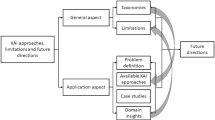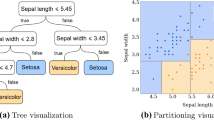Abstract
Abductive reasoning involves generating an explanation for a given set of observations about the world. Abduction provides a good reasoning framework for many AI problems, including diagnosis, plan recognition and learning. This paper focuses on the use of abductive reasoning in diagnostic systems in which there may be more than one underlying cause for the observed symptoms. In exploring this topic, we will review and compare several different approaches, including Binary Choice Bayesian, Sequential Bayesian, Causal Model Based Abduction, Parsimonious Set Covering, and the use of First Order Logic. Throughout the paper we will use as an example a simple diagnostic problem involving automotive troubleshooting.
Similar content being viewed by others
References
Allen, J. (1982) Recognizing intentions from natural language utterances. In Computational Models of Discourse (ed. M.Brady), MIT Press, Cambridge MA.
Ben-Bassat, M. Carlson, R.W. Puri, et. al. (1980) Pattern based interactive diagnosis of multiple disorders: The MEDAS system. IEEE Transations on Pattern Analysis and Machine Intelligence, vol. 148–160.
Buchanan, B.G. & Shortliffe, E.H. (ed) (1984) Rule-Based Expert Systems: the MYCIN Experiments of the Stanford Heuristic Programming Project. Addison-Wesley, Reading, MA.
Carberry, S. (1987) Plant recognition and its use in understanding dialogue. In User Models in Dialog Systems (eds. A.Kobsa & W.Wahlster) Springer-Verlag, Berlin.
Charniak, E. (1983) The Bayesian basis of common sense medical diagnosis. In Proceedings of the Third National Conference on Artificial Intelligence pp. 70–73. William Kaufman, Inc., Los Altos, California.
deKleer, J. & Williams, B.C. (1986a) Diagnosing Multiple Faults. Technical Report, Xerox PARC, Palo Alto, Calif.
deKleer, J. & Williams, B.C. (1986b) Reasoning about multiple faults. In Proceedings of the Fifth National Conference onArtificial Intelligence, pp. 132–139. Morgan Kaufmann, Palo Alto, Calif.
Finin, T. (1983) Help and advice in task oriented systems. In Eighth International Conference on Artifical Intelligence. International Joint Conference on Artificial Intelligence. Morgan Kaufmann, Calif.
Finin, T., Joshi, A. & Webber, B. (1986) Natural language interactions with artificial experts. Proceedings of the IEEE 74 (7), pp. 921–938.
Genesereth, M. (1979) The role of plans in automated consutation. In Sixth International Conference on Artifical Intelligence, pp. 311–319, Morgan Kaufmann, Palo Alto, Calif.
Genesereth, M.R. (1984) The use of design descriptions in automated idagnosis. Artifical Intelligence Journal, 24, pp. 411–436.
Kaplan, J. (1982) Cooperative responses from a portable natural language database query system. In Computational Models of Discourse (ed. M.Brady) MIT Press, Cambridge.
Kassirer, J.P. & Gorry, G.A. (1978) Clinical problem solving: a behavioural analysis. Annals of Internal Medicine, 89.
Kautz, H. (1985) Toward a theory of plan recognition. Technical Report TR162, Department of Computer Science, University of Rochester, Rochester, NY.
Kautz, H. (1986) Generalized plan recognition. In Proceedings of the Fifth National Conference on Artificial Intelligence pp. 32–37. Morgan Kaufmann, Palo Alto, Calif.
Patil, R.S. (1981) Causal Representation of Patient Illness for Electrolyte and Acid-Base Diagnosis Technical Report MIT/LCS/TR-267, Massachussetts Institute of Technology, Laboratory for Computer Science.
Peng, Y. & Reggia, J.A. (1986) Plausibility of diagnostic hypotheses: the nature of simplicity. In Proceedings of the Fifth National Conference on Artificial Intelligence, pp. 140–145. Morgan Kaufmann, Palo Alto, Calif.
Peng Y. & Reggia J.A. (1986a) Being Comfortable with Plausible Diagnostic Hypotheses. Technical Report TR-1753, University of Maryland, Computer Science Department.
Peng, Y. & Reggia, J.A. (1987b) A probabilistic causal model for diagnostic problem solving-Part I: integrating symbolic causal inference with numeric probabilistic inference. IEEE Transactions on Systems, Man & Cybernetics, 17.
Pollack, M.E. (1986) Inferring Domain Plans in Question-Answering. PhD thesis, Department of Computer and Information Science, University of Pennsylvania.
Pollack, M., Hirschber, J. & Webber, B. (1982) User participation in the reasoning processes of expert systems. In Proceedings of the Second National Conference on Artificial Intelligence. CMU, Pittsburgh PA. A longer version appears as Technical Report CIS-82-9. Department of Computer and Information Science, University of Pennsylvania, July 1982.
PopleJr., H.E. (1973) On the mechanization of abductive logic. In Third International Conference on Artificial Intelligence. pp. 147–152. Morgan Kaufmann, Palo Alto, Calif.
PopleJr., H.E. (1977) The formation of composite hypotheses in diagnostic problem-solving: an exercise in synthetic reasoning. In Fifth International Conference on Artifical Intelligence, pp. 1030–1039. Morgan Kaufmann, Alto, Calif.
Pople, Jr., H.E. (1982) Heuristic methods for imposing structure on ill-structured problems: the structuring of medical diagnoses. In AI in Medicine, (ed. P. Szolovits) pp. 119–190. Westview Press.
Ramsay, C.L., Reggia, J.A., Nau, D.S. & Ferrentino, A. (1986) A comparative analysis of methods for expert systems. International Journal of Man-Machine Studies, 24, 475–499.
Reggia, J.A. (1985) Abductive inference. In Proceedings of the Expert Systems in Government Symposium, pp. 484–489.
Reggia, J.A. & Peng, Y. (1986) Modeling diagnostic reasoning: a summary of parsimonious covering theory. In Proceedings of the IEEE Conference on Computer Applications in Medical Care, pp. 17–29.
Reggia, J.A., Nau, D.S. & Wang, P. (1985a) A formal model of diagnostic inference — part 1: problem formulation and decomposition. Information Sciences, 37, pp. 227–256.
Reggia, J.A., Nau, D.S. & Want, P. (1985b) A formal model of diagnostic inference — part 2: algorithmic solution and application. Information Sciences, 37, 257–285.
Reiter, R. (1985) A Theory of Diagnosis from First Principles. Technical Report TR-187/86, Department of Computer Science, University of Toronto.
Schank, R. & Abelson, R. (1977) Scripts, Plans, Goals and Understanding. Lawrence Erlbaum, Hillsdale, NJ.
Shortliffe, E.H. (1976) Computer-Based Medical Consultations: MYCIN. Elsevier, New York.
Shrager, J. & Finin, T. (1982) An expert system that volunteers advice. In Proceedings of the Second National Conference on Artificial Intelligence, pp. 339–340. Morgan Kaufmann, Palo Alto, Calif.
Swartout, W. (1983) XPLAIN: A system for creating and explaining expert consulting programs. Artifical Intelligence, 21, pp. 285–325.
Weiss, S.M. & Kulikowski, C.A. (1984) A Practical Guide to Designing Expert Systems. Rowman and Allanheld, Publishers.
Wilenski, R. (1983) Planning and Understanding. Addison-Wesley, Reading, Mass.
Author information
Authors and Affiliations
Rights and permissions
About this article
Cite this article
Finin, T., Morris, G. Abductive reasoning in multiple fault diagnosis. Artif Intell Rev 3, 129–158 (1989). https://doi.org/10.1007/BF00128779
Issue Date:
DOI: https://doi.org/10.1007/BF00128779




